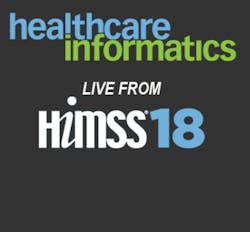Results of the 2018 HIMSS Leadership Survey Confirm CIOs’ Focus on Clinical Outcomes Improvement—and Cybersecurity
While patient safety, clinical informatics, data analytics, and improving quality outcomes remain top of mind among hospital-based healthcare IT leaders, cybersecurity and data privacy and security issues have risen nearly to the top of the list of concerns of those leaders. That’s what the results of the 2018 HIMSS U.S. Leadership and Workforce Survey, released Tuesday, during HIMSS18, indicate.
The leaders of the Chicago-based Healthcare Information and Management Systems Society released those results during the annual HIMSS Conference, being held at the Sands Convention Center in Las Vegas this week. That survey polled 224 healthcare providers (81 percent of whom work in hospitals, 6 percent of whom work in ambulatory care settings, and 13 percent of whom work in nursing homes), and also 145 vendor executives and consultants.
While the priorities of hospital-based healthcare IT leaders remain broadly consistent between this year’s responses and last year’s, some mild shifts have taken place. This year, hospital-based healthcare IT leaders stated the following priorities, in ranked order, as most important to them (on a scale of 1 to 7, with 7 as the highest level): “patient safety” (6.0); “privacy, security, and cybersecurity” (5.90); “process improvement, workflow, change management” (5.7); “clinical informatics and clinician engagement” (5.0); “data analytics/clinical and business intelligence” (5.50); “improving quality outcomes through health IT” (5.48); “compliance, risk management and program integrity” (5.47); “electronic health records” (EHRs; 5.46); “culture of care and care coordination” (5.34).
Last year, hospital-based respondents cited their top-ranked priorities as “quality and patient safety outcomes” (5.85); “electronic health records” (EHRs; 5.83); “privacy, security, and cybersecurity” (5.76); “care coordination, culture of care, and population health” (5.70); and “compliance, risk management and program integrity” (5.31).
“The 2018 HIMSS U.S. Leadership and Workforce Survey reflects the perspectives of U.S. health information and technology leaders on a myriad of topics influencing the healthcare sector,” the executive summary to the report stated. “The present report provides a robust profile of U.S. health information and technology priorities, especially as it relates to hospitals, as well as their linkage to various hospital strategic initiatives (e.g. employment of select information and technology leaders) and industry economic measures (e.g. workforce projections).” The summary noted that “The year-over-year top priorities for Vendors/Consultants and Hospitals remain fairly consistent In comparing the 2017 and 2018 top five priorities for both hospitals and vendors/consultants the audiences appear to be consistent in their assessments. Taking into consideration the modifications to the list of priorities2 between the two years, both groups had three 2017 priorities appear as the top five priorities in 2018. Note too that both groups had “Privacy, Security and Cybersecurity” and components of “Quality and Patient Safety Outcomes” (as listed in the 2017 priority list) appear as top priorities in both 2017 and 2018.”
In a statement issued with the release of the survey results on Tuesday, Lorren Pettit, vice president, HIS and research, HIMSS, said on the organization’s website that, “Today, HIMSS unveiled the findings of the 2018 U.S. Leadership and Workforce Survey. This annual study offers insight into the information and technology concerns of U.S. health leaders, especially those involved in the hospital marketplace,” Pettit said. “The data suggests a year-over-year consistency in the market’s information and technology priorities with vendors/consultants and Hospital respondents evaluating many priorities with the same degree of intensity,” Petti said in the statement accompanying the survey results’ release. “Yet, the findings also reveal that vendors/consultants and hospital providers do not necessarily share all of the top concerns. These findings lead us to conclude that the market is too complex for health leaders to employ a ‘one-size-fits-all’ approach when addressing the priorities of hospitals. Below are five key findings from this year’s survey.”


